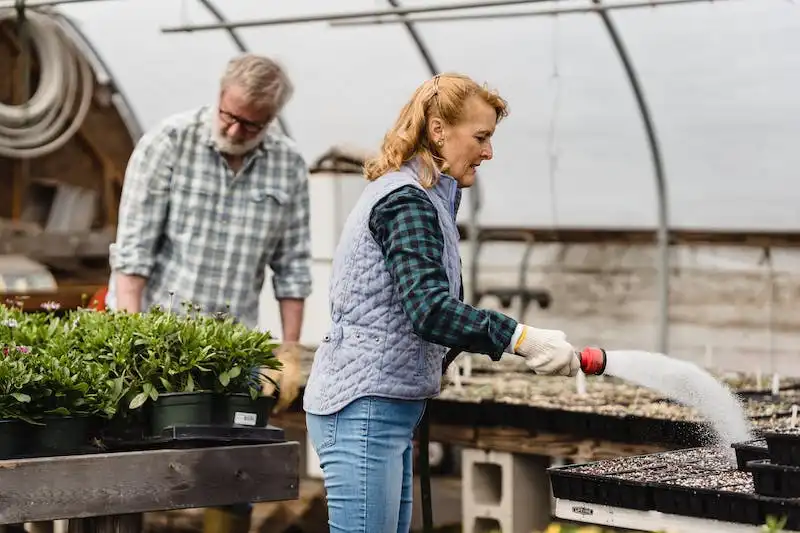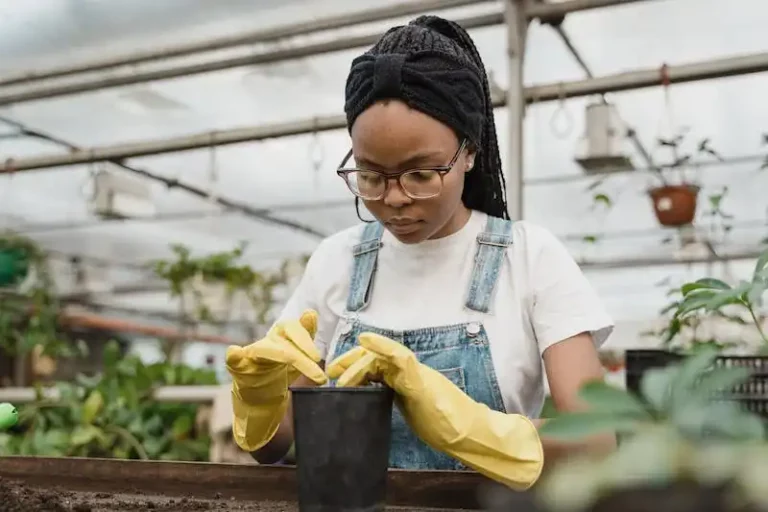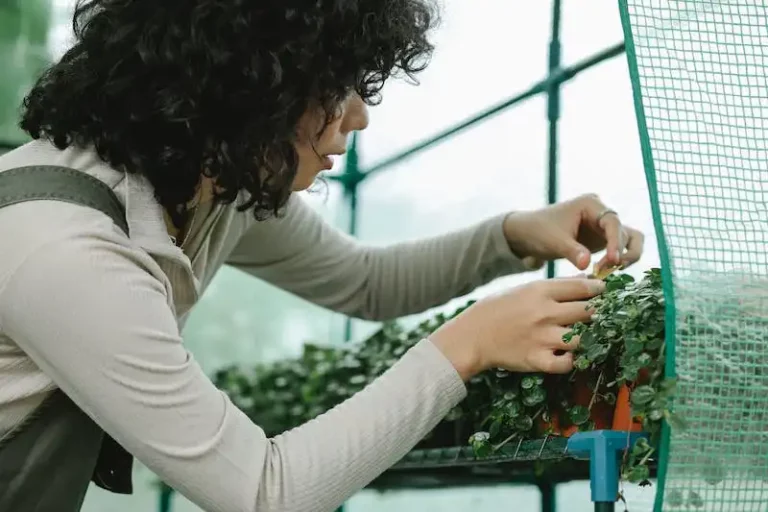There is a saying that “sweet peas are the queen of the garden”, and it’s hard to argue with that. With their beautiful flowers and heavenly scent, sweet peas are a popular choice for any gardener. But how do you go about growing these delicate beauties?
One of the first things to consider is the planting date. Sweet peas are hardy, but they don’t like frost. It’s best to plant them about 6 weeks before the last expected frost date. This gives them enough time to establish a good root system before the frosts hit.
Before planting, you’ll want to prepare your soil. Sweet peas prefer a well-drained soil that is enriched with organic matter. Mixing some compost or well-rotted manure into the soil will help improve its structure and fertility. It’s also a good idea to pre-moisten the soil before planting to ensure that it has enough moisture to support the seedlings.
When it comes to planting, there are two main methods you can use. The first is to sow the seeds directly into the ground. Make a shallow trench about 1 inch deep and place the seeds about 2 inches apart. Cover the seeds with soil and water gently. The second method is to start the seeds indoors and then transplant them outside once they have formed their first true leaves. This gives the seedlings a better chance of surviving and ensures that you have strong and healthy plants.
Once your sweet peas are planted, it’s important to provide them with the right support. Sweet peas are climbing plants and will need something to scramble up. You can use trellises, hoops, or even a piece of netting attached to some stakes. Just make sure that whatever support you choose is strong and flexible enough to handle the weight of the growing vines.
Watering is another important factor in growing sweet peas. They like to be evenly watered, but they don’t like to be waterlogged. A good rule of thumb is to water the plants deeply once a week, or more often if the weather is particularly hot or dry. Mulching around the base of the plants helps to conserve moisture and keep the soil cool.
Regular deadheading is also necessary to keep your sweet peas flowering for as long as possible. This means removing the spent flowers before they have a chance to form seed pods. Deadheading not only keeps the plants looking tidy, but it also encourages more flowers to form.
Pinching back or pruning the plant is another technique that can help to keep sweet peas in tip-top shape. This involves removing the tips of the main stems to encourage bushier growth. It’s best to do this when the plants are young and still actively growing.
So, if you follow this advice and look after your sweet peas properly, you’ll be rewarded with a great display of beautiful flowers and an amazing scent. Growing sweet peas can be a bit of work, but the result is definitely worth it.
As the old saying goes, “a little bit of love and attention goes a long way!”
And with sweet peas, that couldn’t be more true. So roll up your sleeves, get out in the garden, and start growing those sweet peas!
How to Grow Sweet Peas
Sweet peas are beautiful and fragrant flowers that can add charm to any garden. If you want to grow sweet peas in your garden, follow these steps to ensure their successful growth:
| Source: | Morgan Sanderson |
| Sowing: | Sow sweet peas in the early spring, around 6 weeks before the last frost date. Soak the seeds overnight before sowing to improve germination. Provide an appropriate potting mix, and sow the seeds about an inch deep into the soil, spacing them evenly. Water the soil regularly to keep it moist. |
| Germination: | Germination usually takes about 2 weeks. Once the seedlings have emerged, thin them out to leave only the strongest plants, about 6 inches apart. Remove any weeds or other plants that may compete for nutrients. |
| Transplants: | If you’re starting with transplants instead of seeds, be sure to handle them gently to avoid damaging their delicate roots. Dig a hole deep enough to accommodate the roots and plant the seedling, leaving the top leaves above ground level. Firmly press the soil around the plant. |
| Support: | Sweet peas are climbing plants and need support to grow vertically. Provide a trellis, fence, or line to which they can cling. As they grow, gently tie the stems to the support using garden twine or clips. |
| Watering: | Water your sweet peas regularly, aiming for consistently moist soil. Be careful not to overwater them, as this can lead to root rot. Mulch the surface of the soil with black plastic or other organic materials to help retain moisture. |
| Fertilization: | Feed your sweet peas every 2-3 weeks with an appropriate plant fertilizer. Follow the instructions on the packet for the correct dosage. |
| Sunlight: | Sweet peas love full sun but can tolerate partial shade. Make sure they receive at least 6 hours of direct sunlight each day for healthy growth and flowering. |
| Climate and Regions: | Sweet peas can be grown in different climates and regions, but they tend to do the best in cool, temperate areas. They are also suitable for growing in containers. |
| Pest and Disease Control: | Keep an eye out for pests like aphids and slugs, as well as diseases like powdery mildew. Regularly inspect the plants and take appropriate actions to prevent and control infestations. |
| Pruning: | Remove any faded or dead flowers to encourage continued blooming. Pinching back the tips of the plants when they reach about 6 inches in height will promote branching and result in more flowers. |
| Winter Care: | In colder regions, sweet peas may not survive the winter. Before the first frost, cut back the plants to ground level and cover the area with a thick layer of mulch to protect the roots. In milder climates, sweet peas may continue to grow and flower throughout the winter. |
| Varieties: | There are many varieties of sweet peas available, offering a wide range of colors and fragrance. Choose the ones that you like best and that are suitable for your growing conditions. |
By following these guidelines, you can successfully grow sweet peas in your garden and enjoy their beautiful blooms and delightful scent throughout the season.
What You Will Need
When it comes to growing sweet peas, there are a few crucial things you will need to have in order to ensure successful growth and blooming. Here is a list of items you will need:
1. Seeds: It goes without saying that you will need sweet pea seeds to get started. You can find a wide variety of sweet pea varieties available, each with its own unique color and scent.
2. Seedling pots: Small pots will be needed to sow the sweet pea seeds and provide enough room for germination. Make sure the pots have good drainage to prevent overwatering.
3. Potting soil: Use a high-quality potting soil that provides good drainage and nutrients to support the growth of your sweet pea plants.
4. Pre-moistened sand: Pre-moistened sand is useful for improving the germination rate of your sweet pea seeds. It helps to keep the seeds quenched and prevents them from drying out.
5. Sprinkles: Sprinkles are small, round plastic discs that can be placed on the surface of the soil to help improve germination. They absorb and retain moisture, keeping the seedlings hydrated.
6. A frame or support system: Sweet peas are climbing plants and will need some kind of support to grow properly. You can use bamboo canes, wire hoops, or a trellis to provide support for your sweet peas.
7. Netting: Netting is necessary to protect your sweet pea plants from birds and other pests. It should be placed on the support system to create a barrier around the plants.
8. Afternoon shade: Sweet peas prefer cooler temperatures and thrive in afternoon shade. Plant them in a spot that receives shade during the hottest part of the day.
9. Frost protection: If you live in an area with late spring frosts, you will need to provide frost protection for your sweet peas. Use a row cover or cloche to shield them from frost damage.
10. Watering can: Regular watering is essential for the growth and blooming of sweet peas. Use a watering can or hose with a fine spray to water them gently, ensuring the water reaches the roots.
11. Pinching technique: To encourage bushier growth and more blooms, you will need to pinch the tips of your sweet pea plants. This technique involves gently removing the top part of the plant, just above a set of leaves.
12. Sweet scent: One of the best things about sweet peas is their delightful scent. Choose scented varieties to fill your garden with their sweet fragrance.
By having these essential items on hand, you will be well-equipped to start growing and enjoying beautiful sweet peas in your garden.
Method
When it comes to growing sweet peas, there are a few different methods you can use. Here is some advice on a highly recommended method:
Start by planting your sweet pea seeds indoors around 6-8 weeks prior to your last frost date. Fill a container with a well-draining potting mix, making sure to water it beforehand so it’s evenly moist but not soaked. Make sure the container has drainage holes to prevent waterlogged soil.
Next, plant your sweet pea seeds in the container at a depth of about 1 inch, spacing each seed about 2-3 inches apart. Cover the seeds with soil and gently press it down to ensure good contact between the seeds and the soil.
Provide the seeds with appropriate lighting by placing the container in a location that receives bright, indirect light. If natural light is not sufficient, you can use fluorescent lights positioned about 6 inches above the seedlings. Keep the lights on for about 14-16 hours a day.
Keep the container well-watered, making sure to not overwater or let the soil dry out completely. A good technique is to water from below by placing the container in a tray filled with water and allowing the soil to absorb the water through the drainage holes.
As the sweet pea seedlings grow, they will need something to climb. You can provide a suitable structure such as a trellis, netting, or a frame. It’s important to secure the stems of the plants to the structure as they grow to keep them well-anchored.
Once the seedlings have grown bigger and have a few sets of true leaves, it’s time to transplant them outdoors. Choose a location that receives full sun or partial shade and has well-draining soil. Prepare the planting area by removing any weeds and amending the soil with compost or a balanced fertilizer.
Before transplanting the seedlings, harden them off by gradually exposing them to outdoor conditions over the course of a week. Start by placing them outdoors in a sheltered spot for a few hours and gradually increase the amount of time they spend outside.
When planting, make sure to space the sweet pea plants about 6 inches apart to give them enough room to grow. Dig a hole slightly larger than the rootball, gently remove the seedling from the container, and place it in the hole. Backfill with soil, firming it gently around the roots.
After planting, water the seedlings thoroughly to ensure they are well-hydrated. If you have any leggy seedlings, you can use a technique called ‘pinching’ where you gently snap off the top few inches of the stem. This encourages the plant to branch out and promotes bushier growth.
Throughout the growing season, make sure to keep the sweet pea plants watered, especially during dry periods. Mulching around the plants can help retain moisture and suppress weed growth. Regularly deadhead faded flowers to encourage more blooms.
Sweet peas are known for their fragrant flowers, so you can bring the beautiful scent indoors by cutting some stems for floral arrangements. Properly conditioned cut sweet pea flowers will last longer if you remove any leaves that will be below the water line and change the water every few days.
As sweet peas are annual plants, they will complete their life cycle within one year. To save seeds for next year, allow some of the flowers to mature and dry on the vine. Once the seed pods turn brown and become hard, harvest them and store them in a cool, dry place until you’re ready to sow them again.
In summary, growing sweet peas can be a rewarding and enjoyable experience. By following this method, you will be able to grow healthy and vibrant sweet pea plants that will bring beauty and fragrance to your garden.




